Overview: Oracle XML Publisher is a template-based publishing solution delivered with the Oracle E-Business Suite. It provides a new approach to report design and publishing by integrating familiar desktop word processing tools with existing E-Business Suite data reporting. At runtime, XML Publisher merges the custom templates with the concurrent request data extracts to generate output in PDF, HTML, RTF, EXCEL (HTML), or even TEXT for use with EFT and EDI transmissions
Basic Need for XML: Consider the following scenarios
We have a RDF report with tabular layout which prints in English
New Requirements:
- User1 wants the same Report needs to be printed in Spanish
- User2 wants the Same Report needs to be printed in chart format
- User3 wants the Same Report output in Excel
- User4 wants the Same Report output to be published on intranet or internet
- User5 wants the Same Report output eliminating few columns and adding few other
A new RDF needs to be created for each requirement stated above or an existing RDF needs to be modified with huge amount of effort but whereas with XML Publisher it can be done very easily.
XML Publisher separates a reports data, layout and translation components into three manageable pieces at design time; at runtime all the three pieces are brought back together by XML Publisher to generate the final formatted, translated outputs like PDF, HTML, XLS and RTF. In future, if any there is any change in layout we just need to add/modify the Layout file
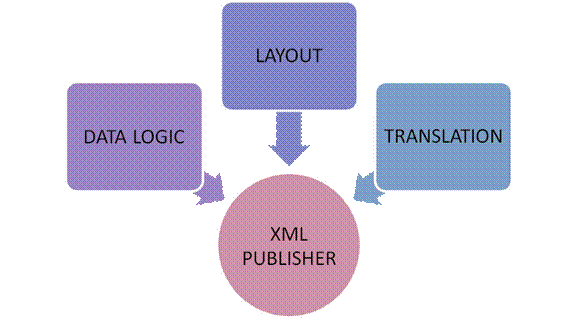
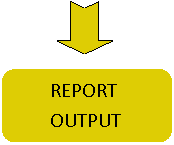
Data Logic: Data extracted from database and converted into an XML string.
Layout: The layout templates to be used for the final output are stored and managed in the Template Manager.
Translation: The translation handler will manage the translation that is required at runtime
In brief the steps are as follows:-
a. Create a procedure and register it as Concurrent Program so that we write XML tags into output file.
b. Build a Data Definition & XML Template using XML Publisher.
c. Create a relation between XML Template & Concurrent Program and run the concurrent program
Requirements for XML Data Object Reports
- Oracle XML Publisher Release 5.5 patch 4206181
- Template Builder 5.5
Template builder is used to create template/layout for your report. Usually Template builder 5.5 is available in Oracle XML Publisher patch itself but you can also download it from http://edelivery.oracle.com. First select Oracle Application Server Products then select your platform and then locate the Oracle XML Publisher Release 5.6.2 Media Pack v1 for Microsoft Windows, as below:
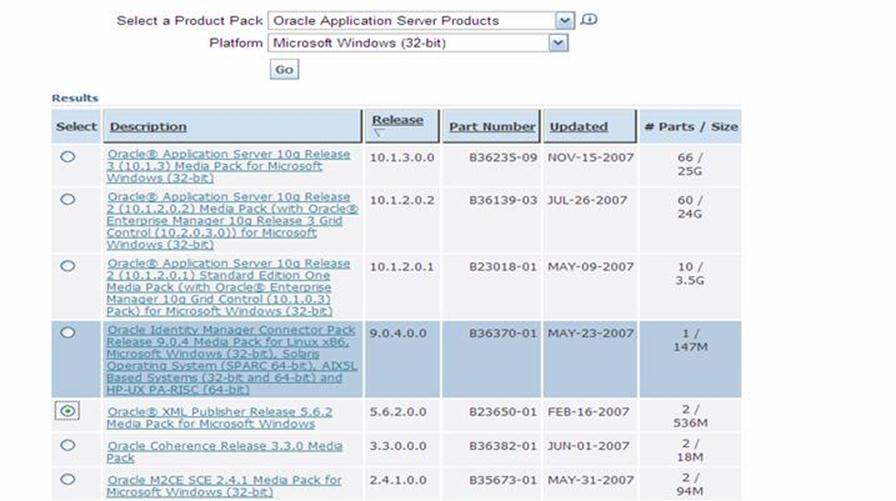
Download the Desktop edition from the below:
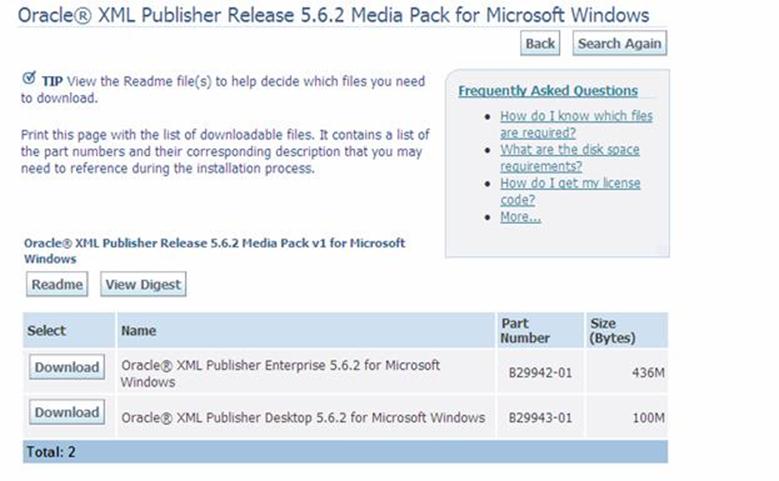
When you download the XML Publisher Desktop edition you get a Zip file containing setup for XML Publisher Desktop Install Shield, this installs some components into Microsoft Word.
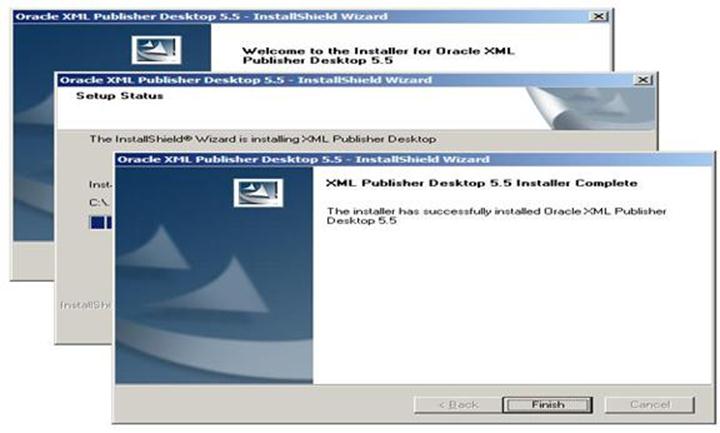
After installing, the Word Add-Ins is attached to the menu bar for the word document. This menu lets you attach an XML data source document, add the XML data to your template, set preferences and preview the output.

In detail along with screenshots:-
A concurrent program is written that spit out an XML file as output such concurrent program can be of type SQL or PL/SQL or Oracle Report or any other supportable type, provided it can produce a XML output.
1. Here I have a very simple PL/SQL procedure, which fetch the records from AR tables and write the output in xml tags.
CREATE OR REPLACE PROCEDURE APPS.Demo_XML_Publisher (errbuf VARCHAR2,retcode NUMBER,v_customer_id VARCHAR2) AS /*Cursor to fetch Customer Records*/ CURSOR xml_parent IS SELECT customer_name , customer_id FROM ra_customers WHERE customer_id = to_number(v_customer_id); /*Cursor to fetch customer invoice records*/ CURSOR xml_detail(p_customer_id1 NUMBER) IS SELECT ra.customer_trx_id customer_trx_id, ra.ship_to_customer_id ship_to_customer_id, ra.trx_number trx_number,aps.amount_due_original ams FROM ra_customer_trx_all ra, ar_payment_schedules_all aps WHERE ra.ship_to_customer_id = p_customer_id1 AND aps.customer_trx_id = ra.customer_trx_id AND ROWNUM<4; BEGIN /*First line of XML data should be <?xml version="1.0"?>*/ FND_FILE.PUT_LINE(FND_FILE.OUTPUT,'<?xml version="1.0"?>'); FND_FILE.PUT_LINE(FND_FILE.OUTPUT,'<CUSTOMERINFO>'); FOR v_customer IN xml_parent LOOP /*For each record create a group tag <P_CUSTOMER> at the start*/ FND_FILE.PUT_LINE(FND_FILE.OUTPUT,'<P_CUSTOMER>'); /*Embed data between XML tags for ex:- <CUSTOMER_NAME>ABCD</CUSTOMER_NAME>*/ FND_FILE.PUT_LINE(FND_FILE.OUTPUT,'<CUSTOMER_NAME>' || v_customer.customer_name || '</CUSTOMER_NAME>'); FND_FILE.PUT_LINE(FND_FILE.OUTPUT,'<CUSTOMER_ID>' || v_customer.customer_id || '</CUSTOMER_ID>'); FOR v_details IN xml_detail(v_customer.customer_id) LOOP /*For customer invoices create a group tag <P_INVOICES> at the start*/ FND_FILE.PUT_LINE(FND_FILE.OUTPUT,'<P_INVOICES>'); FND_FILE.PUT_LINE(FND_FILE.OUTPUT,'<CUSTOMER_TRX_ID>' || v_details.customer_trx_id || '</CUSTOMER_TRX_ID>'); FND_FILE.PUT_LINE(FND_FILE.OUTPUT,'<CUSTOMER_ID>' || v_details.ship_to_customer_id || '</CUSTOMER_ID>'); FND_FILE.PUT_LINE(FND_FILE.OUTPUT,'<INVOICE_NUMBER>'|| v_details.trx_number||'</INVOICE_NUMBER>'); FND_FILE.PUT_LINE(FND_FILE.OUTPUT,'<AMOUNT_DUE_ORIGINAL>'|| v_details.trx_number||'</AMOUNT_DUE_ORIGINAL>'); /*Close the group tag </P_INVOICES> at the end of customer invoices*/ FND_FILE.PUT_LINE(FND_FILE.OUTPUT,'</P_INVOICES>'); END LOOP; /*Close the group tag </P_CUSTOMER> at the end of customer record*/ FND_FILE.PUT_LINE(FND_FILE.OUTPUT,'</P_CUSTOMER>'); END LOOP; /*Finally Close the starting Report tag*/ FND_FILE.PUT_LINE(FND_FILE.OUTPUT,'</CUSTOMERINFO>'); exception when others then FND_FILE.PUT_LINE(FND_FILE.log,'Entered into exception'); END Demo_XML_Publisher; /
2. Create an executable SampleXmlReport for the above procedure Demo_XMML_Publisher.
Go to Application Developer Responsibility->Concurrent->Executable
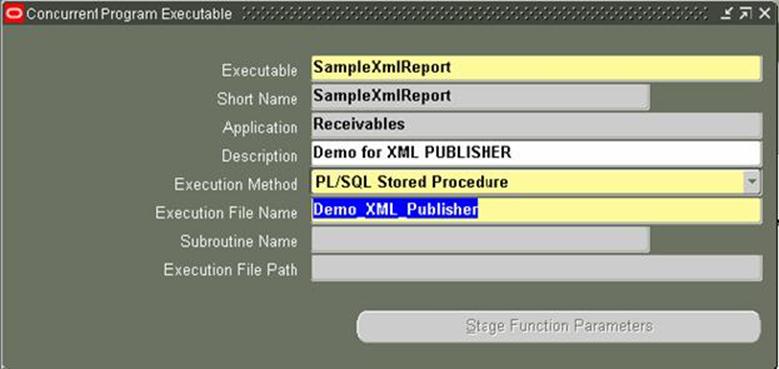
3. Create a new concurrent program SampleXmlReport that will call the SampleXmlReport executable declared above. Make sure that output format is placed as XML.
Go to Application Developer Responsibility -> Concurrent ->Program
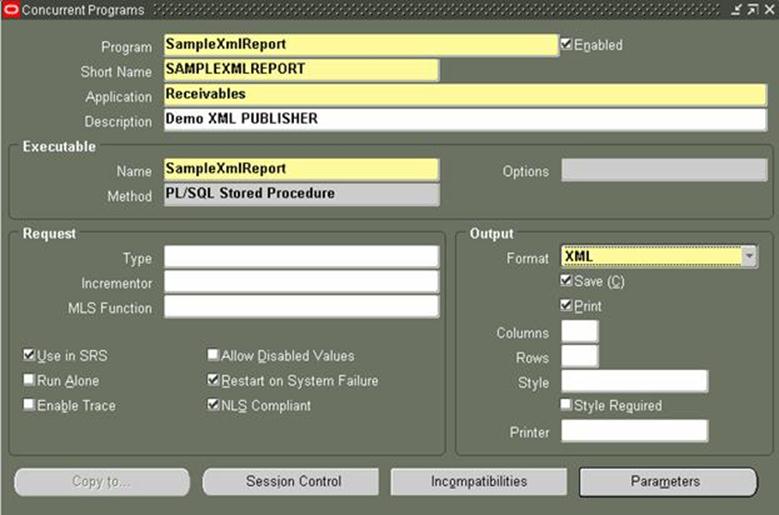
4. Make sure we declare the parameters for the procedure.
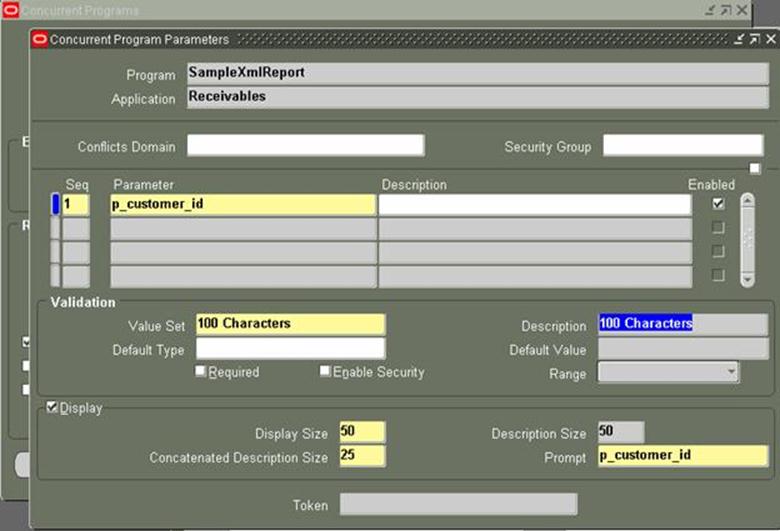
5. Add this new concurrent program with Receivables request group. Either using the following code or through below application screen.
DECLARE
BEGIN
FND_PROGRAM.add_to_group
(
PROGRAM_SHORT_NAME =>'CUST_XML_SAMPLE'
,PROGRAM_APPLICATION =>'AR'
,REQUEST_GROUP => 'Receivables All'
,GROUP_APPLICATION =>'AR'
) ;
commit;
exception
when others then
dbms_output.put_line('Object already exists');
END ;
/
Go to System Administrator Responsibility ->Security ->Responsibility->Request

6. From the receivables responsibility (depends on which responsibility we added our concurrent program here it is receivables)
From the menu View->Requests->Submit A New Request->Single Request
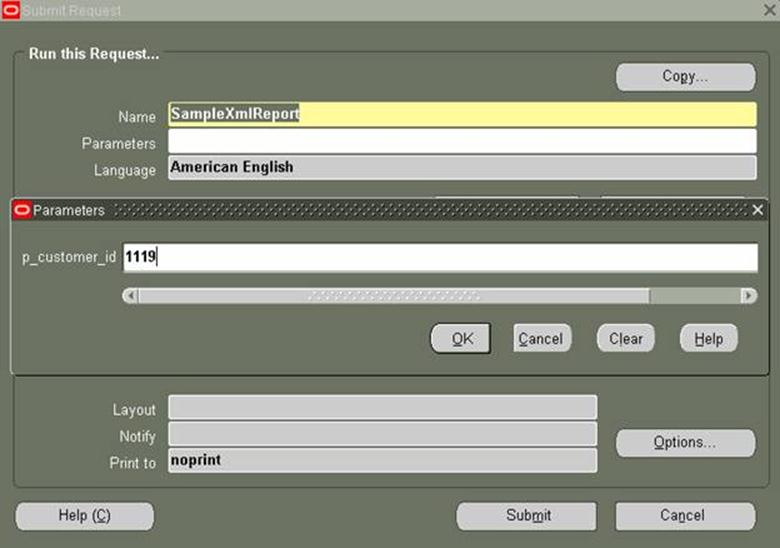
Note: The layout field is blank as we haven’t attached any Template or layout to this concurrent program yet.
By submitting the above request we get the output in xml (depending on procedure) as follows:
<?xml version=”1.0″ ?>
– <CUSTOMERINFO>
– <P_CUSTOMER>
<CUSTOMER_NAME>UNIV OF CHICAGO HOSP</CUSTOMER_NAME>
<CUSTOMER_ID>1119</CUSTOMER_ID>
– <P_INVOICES>
<CUSTOMER_TRX_ID>929476</CUSTOMER_TRX_ID>
<CUSTOMER_ID>1119</CUSTOMER_ID>
<INVOICE_NUMBER>2484403</INVOICE_NUMBER>
<AMOUNT_DUE_ORIGINAL>8000</AMOUNT_DUE_ORIGINAL>
</P_INVOICES>
– <P_INVOICES
<CUSTOMER_TRX_ID>929374</CUSTOMER_TRX_ID>
<CUSTOMER_ID>1119</CUSTOMER_ID>
<INVOICE_NUMBER>2484267</INVOICE_NUMBER>
<AMOUNT_DUE_ORIGINAL>380.68</AMOUNT_DUE_ORIGINAL>
</P_INVOICES>
– <P_INVOICES>
<CUSTOMER_TRX_ID>806644</CUSTOMER_TRX_ID>
<CUSTOMER_ID>1119</CUSTOMER_ID>
<INVOICE_NUMBER>2421373</INVOICE_NUMBER>
<AMOUNT_DUE_ORIGINAL>615.96</AMOUNT_DUE_ORIGINAL>
</P_INVOICES>
</P_CUSTOMER>
</CUSTOMERINFO>
7. Save the above code as SampleXmlReport.xml
Note: Before saving the XML string in notepad remove the dashes –
8. Create Template/Layout for the report using Template Builder. Here is a sample template.
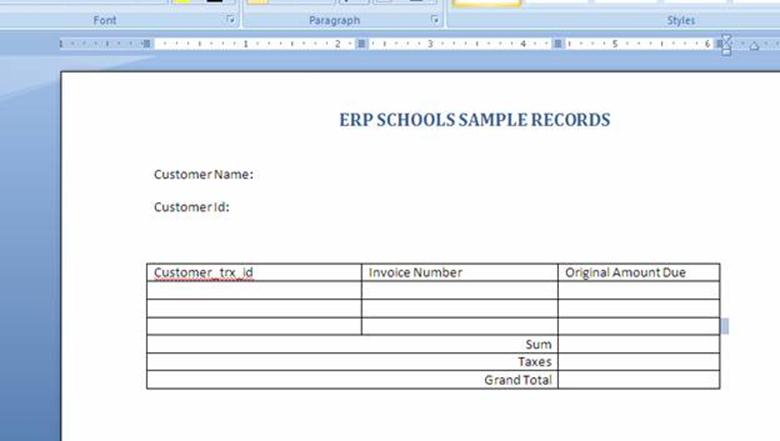
Note the following:
The data fields that are defined on the template
For example: Customer Name, Customer Id
The elements of the template that will repeat when the report is run.
For example, Customer trx id , Invoice Number and Original Amount Due. All these fields on the template will repeat for each Employee that is reported.
9. Mark up your template layout.
Like a mail-merge document there’s placeholders for the data you’re going to add, and then you can add whatever formatting you like.
10. Now the next step is to select Data > Load XML Data from the toolbar menu, then pick up the XML data a file ie.SampleXmlReport.xml. Once the data is loaded, a “Data Loaded Successfully” dialog box comes up and you can then start adding data items to the template.
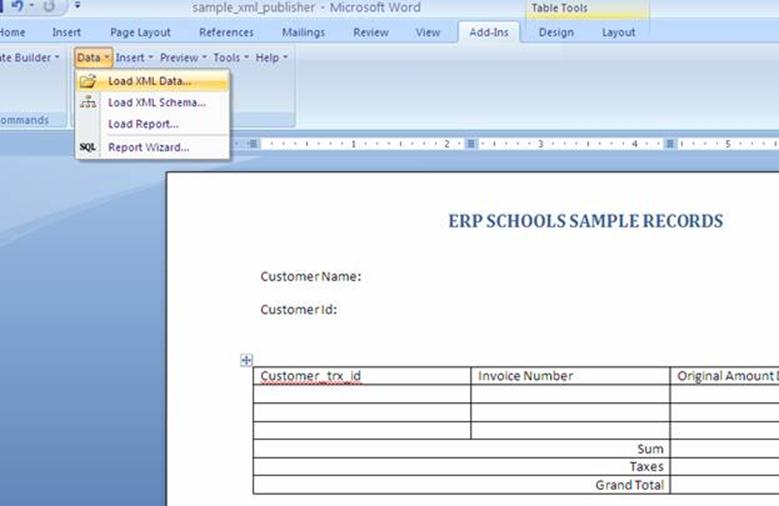
11. To add data items from the XML file into your report, you locate in the document the placeholder for the field you’re going to add, highlight it and then select Insert > Field from the toolbar. A dialog box comes up with all of the available data items, you select the one you want and click insert as shown below:
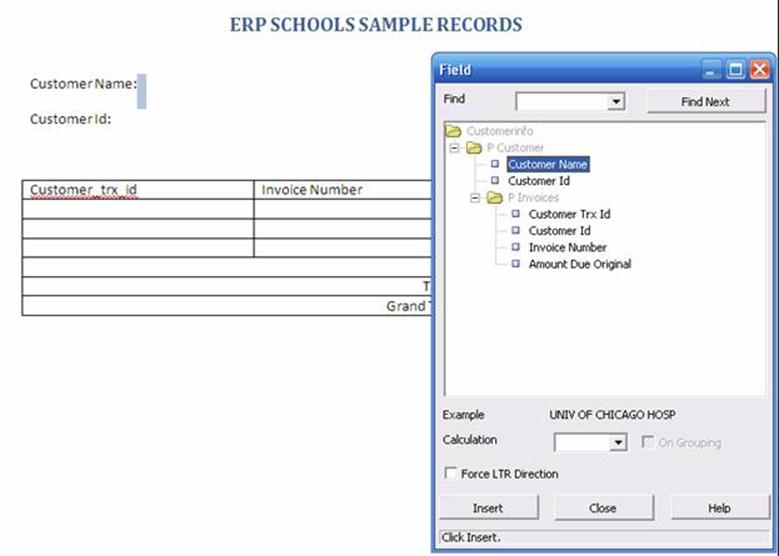
12. You can add repeating rows into your document by selecting Insert > Table/Form from the toolbar. This brings up a different dialog box that lets you drag a parent node – in this case, “P Invoices” – into the middle section, which becomes your repeating rows.
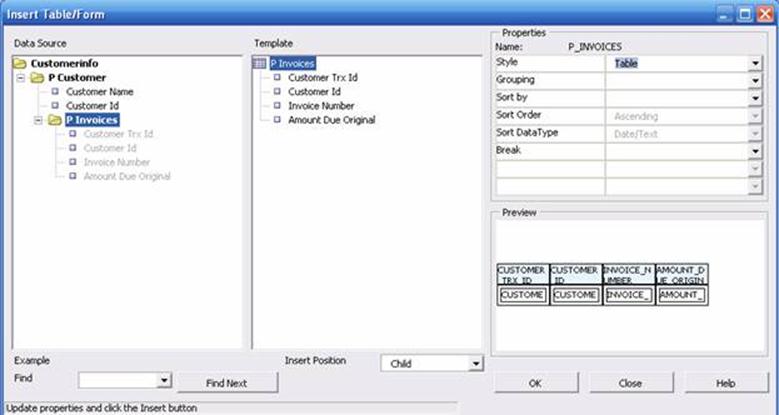
13. Calculate the average for amount due original. Select Insert->Field from the Add Ins toolbar. Then select the tag that calculates the average for that particular field.
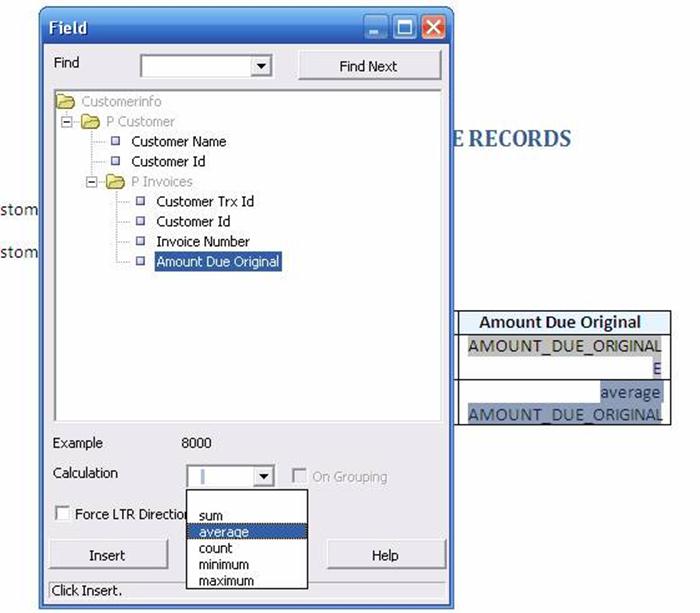
14. Once we are done with adding up all the fields in the template save it as an rtf which looks as below:
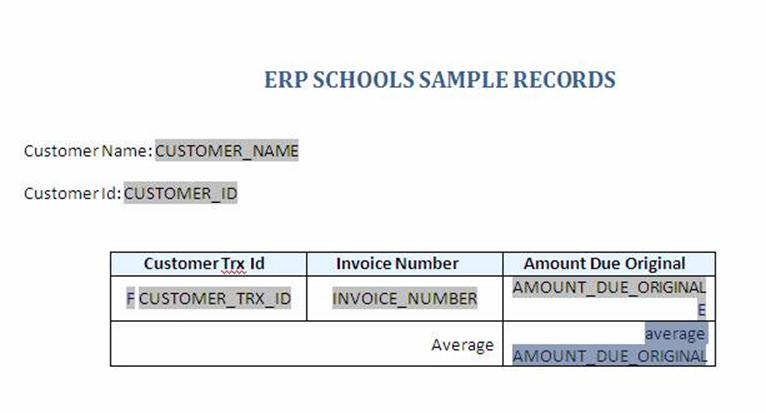
To confirm the output from the template we build. Click on preview and select the type in which format the output is required.
15. Adding the Template to ORACLE Application.
In order to add the template to application the user should have the responsibility XML Publisher Administrator assigned.
In this step we do 2 processes, registering concurrent program as Data Definition in template manager
And register the template using the data definition created.

Go to XML Publisher Administrator->Data Definitions->Create Data definition.
Here we fill all the details to create data definition
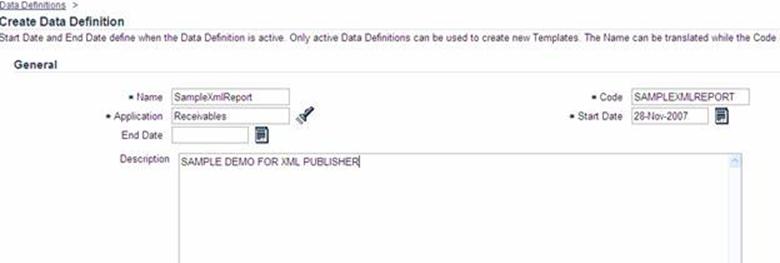
NOTE: Make sure the code of the data definition must be the same as the short name of the Concurrent Program we registered for the procedure. So that the concurrent manager can retrieve the templates associated with the concurrent program
We can add our xml file SampleXmlReport.xml in data definition here:

16. Now create the template with the help of template manager
At the runtime the concurrent managers request interface will present the list of available templates with respect to the data definition registered. We will upload the rtf template file created here. We will select the language and territory.
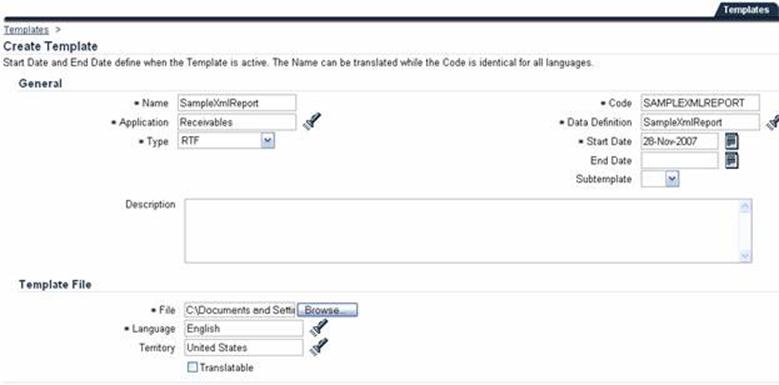
We can upload different templates for different languages and territories.
17. Now run the concurrent program to get the desired output.
From the receivables responsibility, use the submit request form to run the concurrent request.
The default layout is displayed which we can change as per the requirement. For changing the template click on options to look for all templates register with that concurrent program.
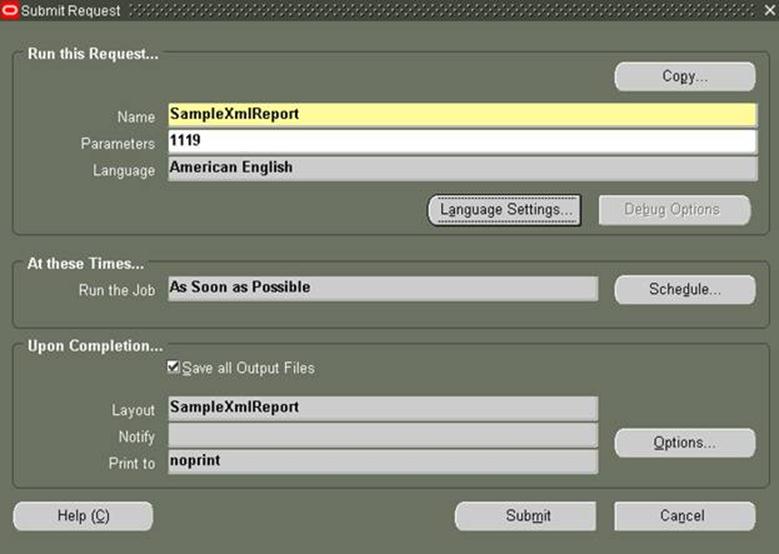
Here in the above example my template is SampleXmlReport which is displayed in layout field.
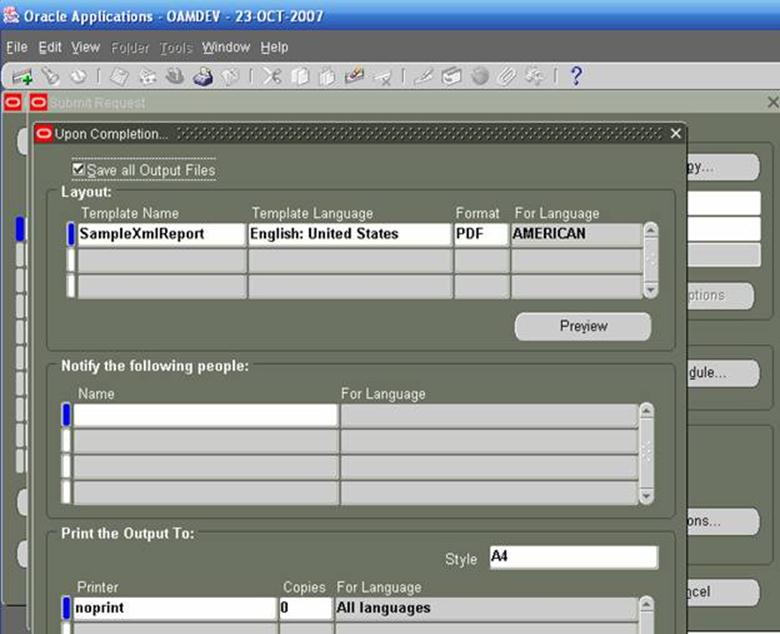
And once the request is submitted we will get the output in PDF as
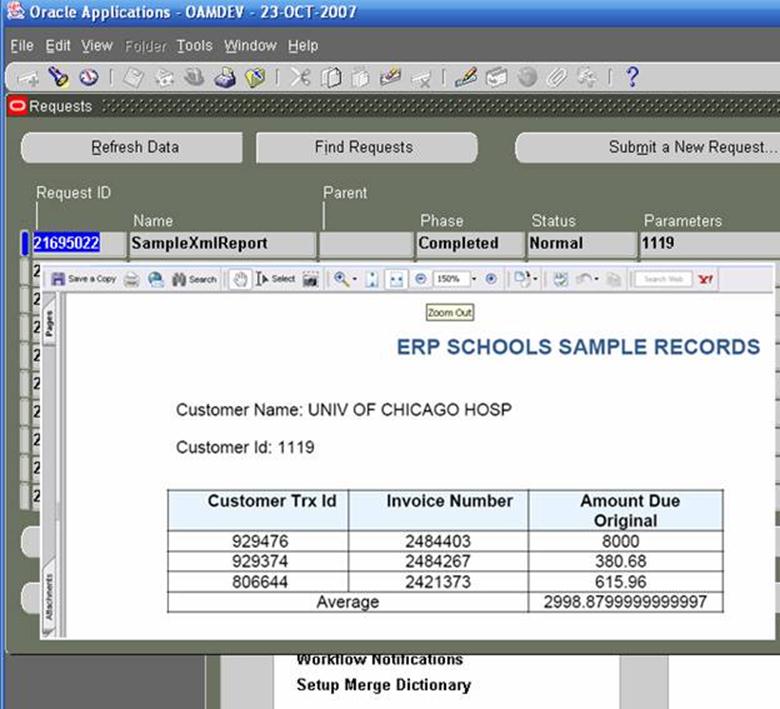
This is the final output as desired in the PDF format.